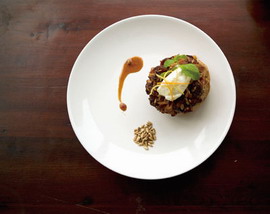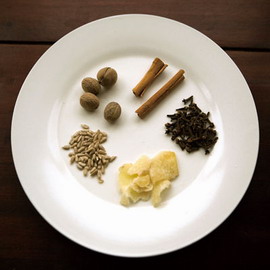 A spicy, boozy, Anglo-Saxon sweet
A spicy, boozy, Anglo-Saxon sweet
I often serve as a cultural interpreter for the food-obsessed Chinese, and the question “So what do they eat?” comes up in one out of every three conversations with locals. Thanksgiving? Turkey. Easter? Leg of lamb. Valentine’s Day? Chocolates and those annoyingly dry heart-shaped sugar cookies sprinkled with neon pink sprinkles that turn your entire mouth radioactive.
But Christmas? Truth is, I’m really not qualified to write about Christmas food. There’s the friend whose family – non-Italian, mind you – serves the largest lasagna imaginable. But I thought disclosing this would be disingenuous to Chinese friends, so at this point I usually run for the nearest copy of Charles Dickens. “Erm … Roasted goose?” I offer. “Oh, roasted goose,” says the questioner, nodding slowly with a look of comprehension as if he had suddenly discovered a shining path through the thicket of cultural misunderstanding: The laowai eat strange poultry too, just like us.
My grandmother’s religion has ardently been, for the last 65 years, a quotidian communism. My parents, like almost all Chinese intellectuals of their generation, were cardholding disciples of the ideology in their youth. So it’s no surprise that our family didn’t have a history of celebrating Christmas. We did celebrate Chinese New Year for the first few years after moving to the States, but the tradition gradually fell by the wayside, my mother moping about the lack of atmosphere. Later, we had an anemic plastic Christmas tree for a year or two, for the sake of appearance, until my Jewish stepfather came into the picture.
Then one Christmas, in Beijing of all places, a very Anglo-Saxon friend brought a very Anglo-Saxon food from abroad in a box: mince pie.I had a sudden moment of reverse Orientalism: Should I be putting something thereto a pottell of ale while holding court with Henry the whateverth? I was wary. Fruitcake I have heard of, but in the States, people have long stopped posturing and even exchanging the much-maligned cakes since no one ate them. Still, I took a bite.
The mince pie was nothing like I’d expected. Moist. Sweet, but not too sweet. Perfumed with spices, and, best of all, like all Anglo-Saxons, boozy. It was everything I’d always expected Christmas to be. I tried to make my own version of mince pie this year. As much as I admire the traditional, unsqueamish addition of suet, I thought asking for the beef fat above the kidneys at the market was going to get me more questions than I wanted to answer, and in the end the fat was probably not going to be from above the kidneys anyways. Instead, I added butter, did away with the crust and stuffed the mince in a giant Fuji apple. Then there was just one thing left to do – make sure it was all boozy enough.
Baked Apples With Mince
Serves 4-5
 2 tablespoons butter
2 tablespoons butter
½ tsp nutmeg
½ tsp cinnamon
4 cloves
2 cups of mixed dried fruit (assorted dried Chinese plums, pears, peaches, raisins) chopped into small pieces
Zest from half an orange
Zest from half a lemon
2/3 cup Cointreau
Pinch of salt
1 tbsp brown sugar
4 Fuji or 5 Granny Smith apples
Vanilla ice cream
Melt butter in a pan. To make the mince, add nutmeg, cinnamon and cloves, and simmer for two minutes, making sure not to burn the butter. In an airtight container add butter and spices, dried fruit, zests, Cointreau, salt and sugar. Close the lid and shake the container until well mixed. Set aside for three or four days, the first day at room temperature and the rest of the time in the fridge. Add more Cointreau if the mixture looks dry. Preheat oven to 215 degrees Celsius (or 425 degrees Fahrenheit). Cut the tops off the apples in a cone shape, and then core each apple with a spoon or melon baller. Spoon the mince into the apple, piling it high. Cover with tin foil so it doesn’t burn. Bake for 30-45 minutes. Serve warm with vanilla ice cream.



